Tax Implications of Various Cash Inflows and Outflows for Employee and Employer
VerifiedAdded on 2023/06/04
|12
|3448
|67
AI Summary
This article discusses the tax implications of various cash inflows and outflows for employees and employers. It covers the tax treatment of car benefits, loan extensions, receipts such as salary, commission, entertainment allowance, and subscription, and deductions. The article provides relevant laws and their application to each scenario.
Contribute Materials
Your contribution can guide someone’s learning journey. Share your
documents today.
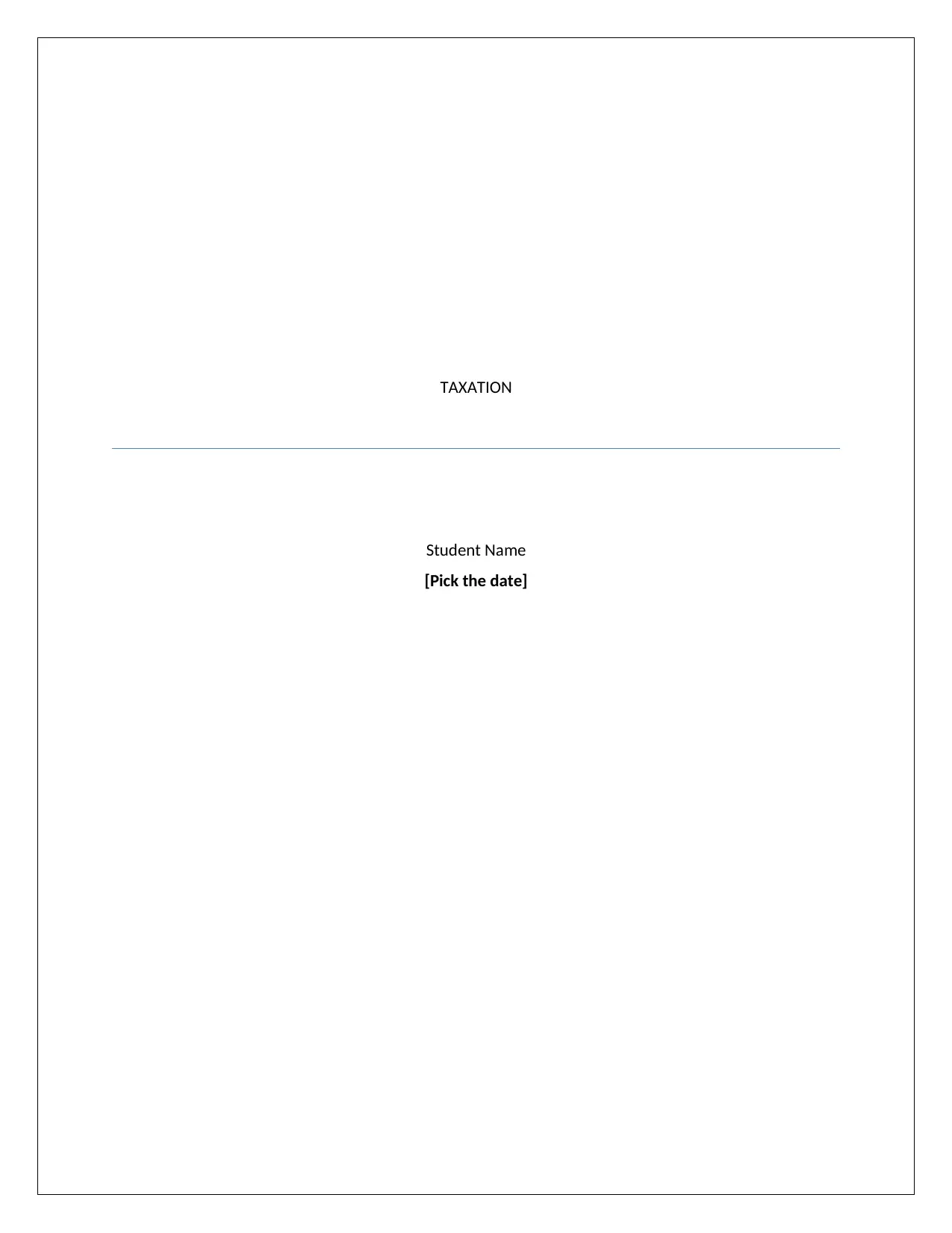
TAXATION
Student Name
[Pick the date]
Student Name
[Pick the date]
Secure Best Marks with AI Grader
Need help grading? Try our AI Grader for instant feedback on your assignments.

Question 1
Issue
As per the case facts outlined, Amber has enacted certain transactions involving sale of certain
assets and other contractual agreements. In this background, it is essential to outline the various
tax liabilities that would potentially arise for Amber. The various issues in this regards are
indicated below.
1) Owing to liquidation to chocolate shop, proceeds would be obtained and it needs to be
outlined if capital gains tax would be applicable on any or all of these assuming the proceeds are
capital.
2) Owing to the contract regarding restrictive covenant, proceeds would be realised and it needs
to be analysed if this is revenue or capital and suitable taxation treatment discussed.
3) Owing to the apartment sale, the tax treatment of the proceeds and potential capital gains
implications of the same.
Law
The relevant law keeping in mind the various transactions have been discussed as indicated
below.
Sale of Shop
The first critical question that arises with regards to certain assets is whether these can be
labelled as capital assets or not. To answer the same, s. 108-5 ITAA 1997 is relevant since it lists
down the various capital assets from the perspective of taxation. A noteworthy aspect as per this
section is that capital assets does not consist of only tangible assets but also consists of intangible
assets (example: goodwill) (Woellner, 2015). Identification of assets as capital assets is a key
step as for a capital asset the proceeds arising from sale would be capital and hence tax free.
Thus, in case of capital assets sale, the only potential tax implications can arise on account of
loss or gain in capital owing to higher or lower cash proceeds when compared with the cost base.
Another vital point to note is that in case of trading stock any capital gains or loss would be
ignored from CGT liability in accordance with s. 118-25 ITAA 1997 (Sadiq et. al., 2015).
1
Issue
As per the case facts outlined, Amber has enacted certain transactions involving sale of certain
assets and other contractual agreements. In this background, it is essential to outline the various
tax liabilities that would potentially arise for Amber. The various issues in this regards are
indicated below.
1) Owing to liquidation to chocolate shop, proceeds would be obtained and it needs to be
outlined if capital gains tax would be applicable on any or all of these assuming the proceeds are
capital.
2) Owing to the contract regarding restrictive covenant, proceeds would be realised and it needs
to be analysed if this is revenue or capital and suitable taxation treatment discussed.
3) Owing to the apartment sale, the tax treatment of the proceeds and potential capital gains
implications of the same.
Law
The relevant law keeping in mind the various transactions have been discussed as indicated
below.
Sale of Shop
The first critical question that arises with regards to certain assets is whether these can be
labelled as capital assets or not. To answer the same, s. 108-5 ITAA 1997 is relevant since it lists
down the various capital assets from the perspective of taxation. A noteworthy aspect as per this
section is that capital assets does not consist of only tangible assets but also consists of intangible
assets (example: goodwill) (Woellner, 2015). Identification of assets as capital assets is a key
step as for a capital asset the proceeds arising from sale would be capital and hence tax free.
Thus, in case of capital assets sale, the only potential tax implications can arise on account of
loss or gain in capital owing to higher or lower cash proceeds when compared with the cost base.
Another vital point to note is that in case of trading stock any capital gains or loss would be
ignored from CGT liability in accordance with s. 118-25 ITAA 1997 (Sadiq et. al., 2015).
1
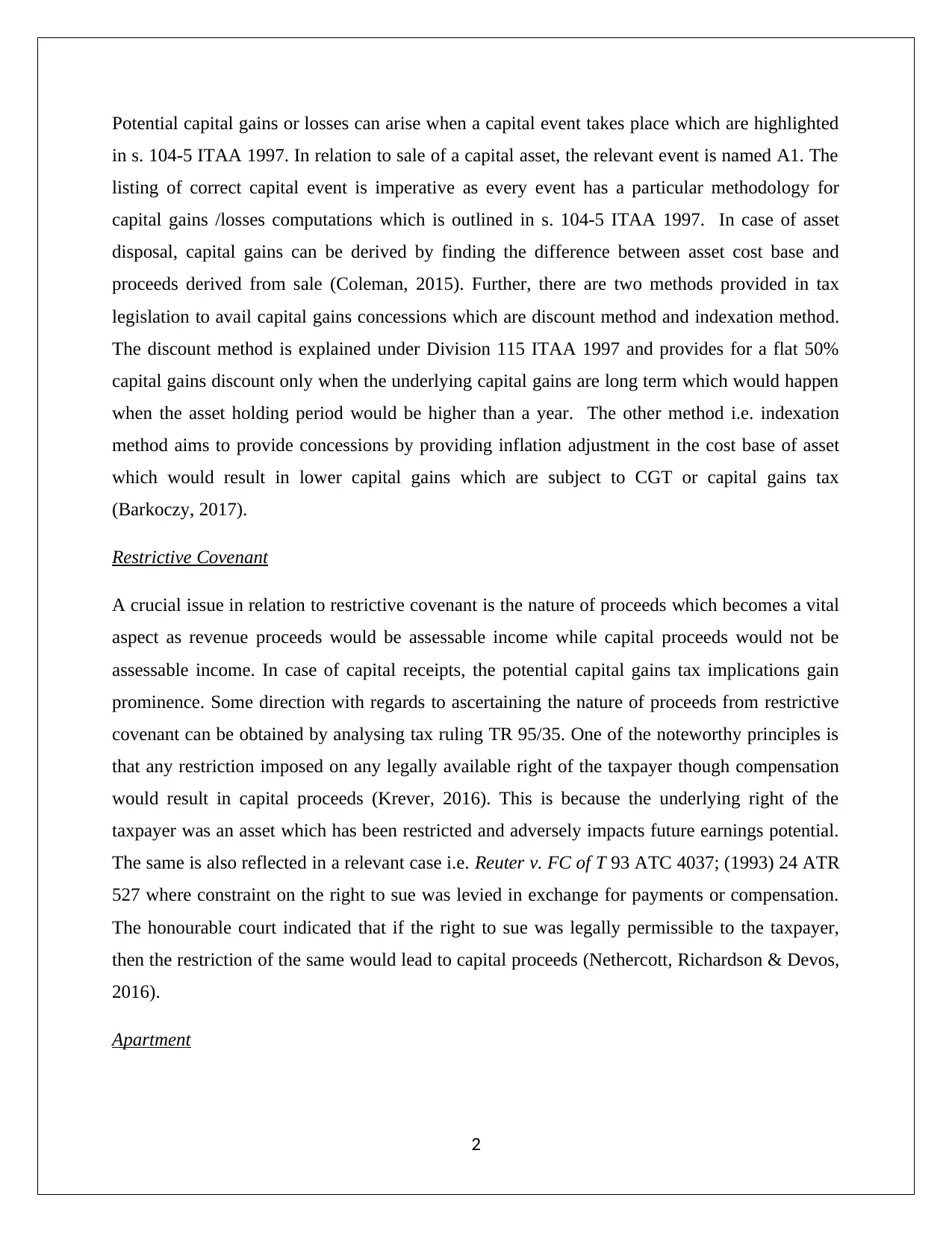
Potential capital gains or losses can arise when a capital event takes place which are highlighted
in s. 104-5 ITAA 1997. In relation to sale of a capital asset, the relevant event is named A1. The
listing of correct capital event is imperative as every event has a particular methodology for
capital gains /losses computations which is outlined in s. 104-5 ITAA 1997. In case of asset
disposal, capital gains can be derived by finding the difference between asset cost base and
proceeds derived from sale (Coleman, 2015). Further, there are two methods provided in tax
legislation to avail capital gains concessions which are discount method and indexation method.
The discount method is explained under Division 115 ITAA 1997 and provides for a flat 50%
capital gains discount only when the underlying capital gains are long term which would happen
when the asset holding period would be higher than a year. The other method i.e. indexation
method aims to provide concessions by providing inflation adjustment in the cost base of asset
which would result in lower capital gains which are subject to CGT or capital gains tax
(Barkoczy, 2017).
Restrictive Covenant
A crucial issue in relation to restrictive covenant is the nature of proceeds which becomes a vital
aspect as revenue proceeds would be assessable income while capital proceeds would not be
assessable income. In case of capital receipts, the potential capital gains tax implications gain
prominence. Some direction with regards to ascertaining the nature of proceeds from restrictive
covenant can be obtained by analysing tax ruling TR 95/35. One of the noteworthy principles is
that any restriction imposed on any legally available right of the taxpayer though compensation
would result in capital proceeds (Krever, 2016). This is because the underlying right of the
taxpayer was an asset which has been restricted and adversely impacts future earnings potential.
The same is also reflected in a relevant case i.e. Reuter v. FC of T 93 ATC 4037; (1993) 24 ATR
527 where constraint on the right to sue was levied in exchange for payments or compensation.
The honourable court indicated that if the right to sue was legally permissible to the taxpayer,
then the restriction of the same would lead to capital proceeds (Nethercott, Richardson & Devos,
2016).
Apartment
2
in s. 104-5 ITAA 1997. In relation to sale of a capital asset, the relevant event is named A1. The
listing of correct capital event is imperative as every event has a particular methodology for
capital gains /losses computations which is outlined in s. 104-5 ITAA 1997. In case of asset
disposal, capital gains can be derived by finding the difference between asset cost base and
proceeds derived from sale (Coleman, 2015). Further, there are two methods provided in tax
legislation to avail capital gains concessions which are discount method and indexation method.
The discount method is explained under Division 115 ITAA 1997 and provides for a flat 50%
capital gains discount only when the underlying capital gains are long term which would happen
when the asset holding period would be higher than a year. The other method i.e. indexation
method aims to provide concessions by providing inflation adjustment in the cost base of asset
which would result in lower capital gains which are subject to CGT or capital gains tax
(Barkoczy, 2017).
Restrictive Covenant
A crucial issue in relation to restrictive covenant is the nature of proceeds which becomes a vital
aspect as revenue proceeds would be assessable income while capital proceeds would not be
assessable income. In case of capital receipts, the potential capital gains tax implications gain
prominence. Some direction with regards to ascertaining the nature of proceeds from restrictive
covenant can be obtained by analysing tax ruling TR 95/35. One of the noteworthy principles is
that any restriction imposed on any legally available right of the taxpayer though compensation
would result in capital proceeds (Krever, 2016). This is because the underlying right of the
taxpayer was an asset which has been restricted and adversely impacts future earnings potential.
The same is also reflected in a relevant case i.e. Reuter v. FC of T 93 ATC 4037; (1993) 24 ATR
527 where constraint on the right to sue was levied in exchange for payments or compensation.
The honourable court indicated that if the right to sue was legally permissible to the taxpayer,
then the restriction of the same would lead to capital proceeds (Nethercott, Richardson & Devos,
2016).
Apartment
2
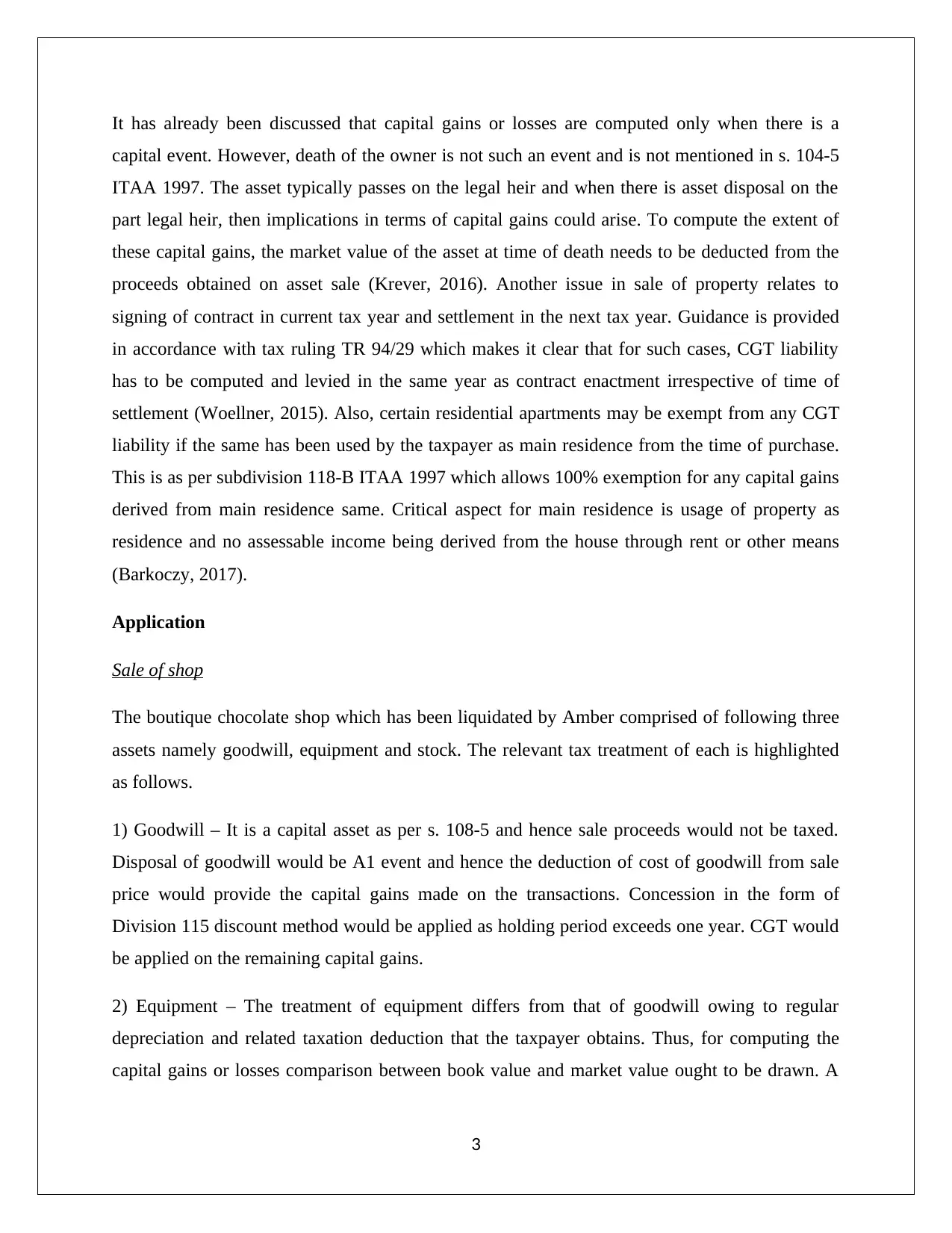
It has already been discussed that capital gains or losses are computed only when there is a
capital event. However, death of the owner is not such an event and is not mentioned in s. 104-5
ITAA 1997. The asset typically passes on the legal heir and when there is asset disposal on the
part legal heir, then implications in terms of capital gains could arise. To compute the extent of
these capital gains, the market value of the asset at time of death needs to be deducted from the
proceeds obtained on asset sale (Krever, 2016). Another issue in sale of property relates to
signing of contract in current tax year and settlement in the next tax year. Guidance is provided
in accordance with tax ruling TR 94/29 which makes it clear that for such cases, CGT liability
has to be computed and levied in the same year as contract enactment irrespective of time of
settlement (Woellner, 2015). Also, certain residential apartments may be exempt from any CGT
liability if the same has been used by the taxpayer as main residence from the time of purchase.
This is as per subdivision 118-B ITAA 1997 which allows 100% exemption for any capital gains
derived from main residence same. Critical aspect for main residence is usage of property as
residence and no assessable income being derived from the house through rent or other means
(Barkoczy, 2017).
Application
Sale of shop
The boutique chocolate shop which has been liquidated by Amber comprised of following three
assets namely goodwill, equipment and stock. The relevant tax treatment of each is highlighted
as follows.
1) Goodwill – It is a capital asset as per s. 108-5 and hence sale proceeds would not be taxed.
Disposal of goodwill would be A1 event and hence the deduction of cost of goodwill from sale
price would provide the capital gains made on the transactions. Concession in the form of
Division 115 discount method would be applied as holding period exceeds one year. CGT would
be applied on the remaining capital gains.
2) Equipment – The treatment of equipment differs from that of goodwill owing to regular
depreciation and related taxation deduction that the taxpayer obtains. Thus, for computing the
capital gains or losses comparison between book value and market value ought to be drawn. A
3
capital event. However, death of the owner is not such an event and is not mentioned in s. 104-5
ITAA 1997. The asset typically passes on the legal heir and when there is asset disposal on the
part legal heir, then implications in terms of capital gains could arise. To compute the extent of
these capital gains, the market value of the asset at time of death needs to be deducted from the
proceeds obtained on asset sale (Krever, 2016). Another issue in sale of property relates to
signing of contract in current tax year and settlement in the next tax year. Guidance is provided
in accordance with tax ruling TR 94/29 which makes it clear that for such cases, CGT liability
has to be computed and levied in the same year as contract enactment irrespective of time of
settlement (Woellner, 2015). Also, certain residential apartments may be exempt from any CGT
liability if the same has been used by the taxpayer as main residence from the time of purchase.
This is as per subdivision 118-B ITAA 1997 which allows 100% exemption for any capital gains
derived from main residence same. Critical aspect for main residence is usage of property as
residence and no assessable income being derived from the house through rent or other means
(Barkoczy, 2017).
Application
Sale of shop
The boutique chocolate shop which has been liquidated by Amber comprised of following three
assets namely goodwill, equipment and stock. The relevant tax treatment of each is highlighted
as follows.
1) Goodwill – It is a capital asset as per s. 108-5 and hence sale proceeds would not be taxed.
Disposal of goodwill would be A1 event and hence the deduction of cost of goodwill from sale
price would provide the capital gains made on the transactions. Concession in the form of
Division 115 discount method would be applied as holding period exceeds one year. CGT would
be applied on the remaining capital gains.
2) Equipment – The treatment of equipment differs from that of goodwill owing to regular
depreciation and related taxation deduction that the taxpayer obtains. Thus, for computing the
capital gains or losses comparison between book value and market value ought to be drawn. A
3
Secure Best Marks with AI Grader
Need help grading? Try our AI Grader for instant feedback on your assignments.
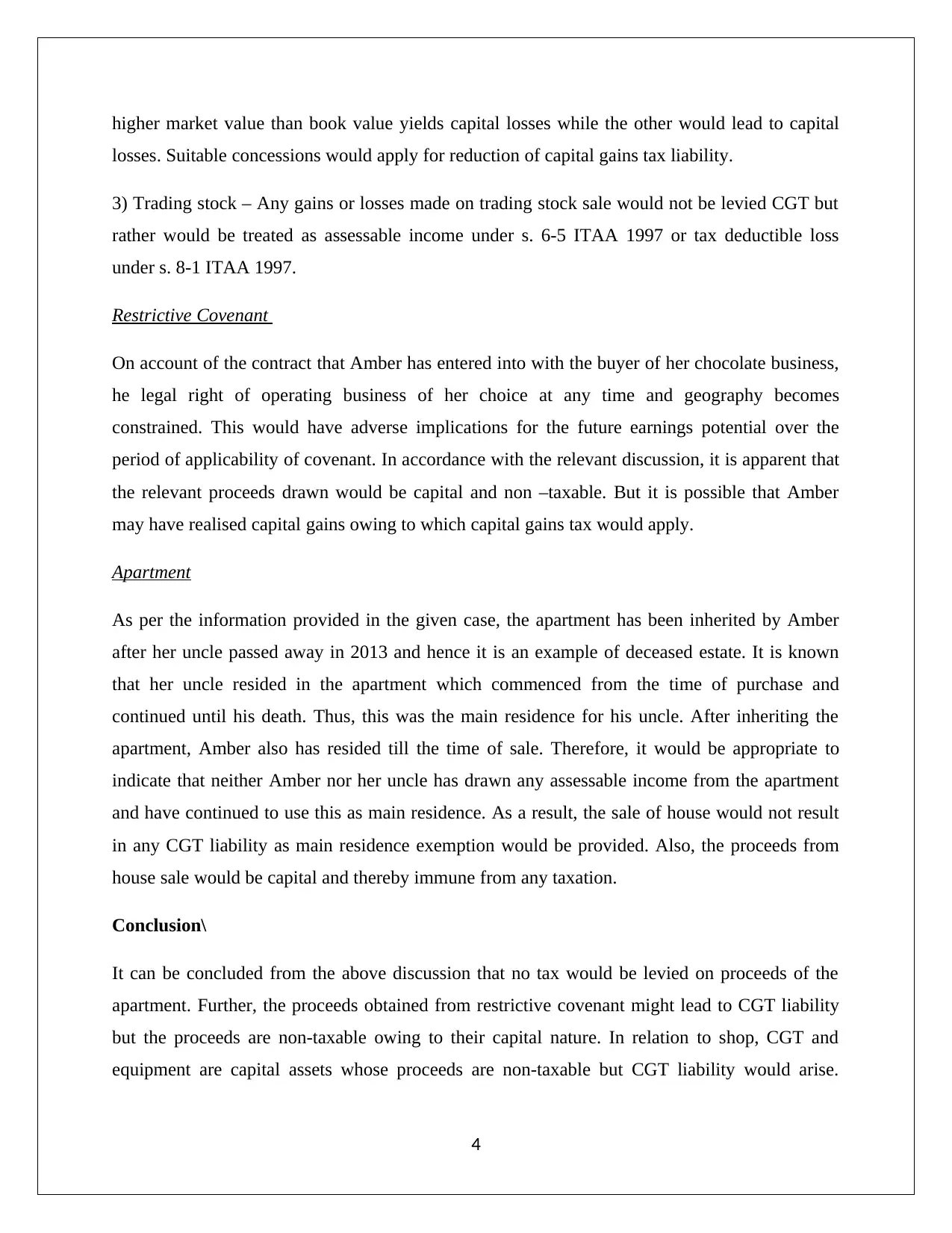
higher market value than book value yields capital losses while the other would lead to capital
losses. Suitable concessions would apply for reduction of capital gains tax liability.
3) Trading stock – Any gains or losses made on trading stock sale would not be levied CGT but
rather would be treated as assessable income under s. 6-5 ITAA 1997 or tax deductible loss
under s. 8-1 ITAA 1997.
Restrictive Covenant
On account of the contract that Amber has entered into with the buyer of her chocolate business,
he legal right of operating business of her choice at any time and geography becomes
constrained. This would have adverse implications for the future earnings potential over the
period of applicability of covenant. In accordance with the relevant discussion, it is apparent that
the relevant proceeds drawn would be capital and non –taxable. But it is possible that Amber
may have realised capital gains owing to which capital gains tax would apply.
Apartment
As per the information provided in the given case, the apartment has been inherited by Amber
after her uncle passed away in 2013 and hence it is an example of deceased estate. It is known
that her uncle resided in the apartment which commenced from the time of purchase and
continued until his death. Thus, this was the main residence for his uncle. After inheriting the
apartment, Amber also has resided till the time of sale. Therefore, it would be appropriate to
indicate that neither Amber nor her uncle has drawn any assessable income from the apartment
and have continued to use this as main residence. As a result, the sale of house would not result
in any CGT liability as main residence exemption would be provided. Also, the proceeds from
house sale would be capital and thereby immune from any taxation.
Conclusion\
It can be concluded from the above discussion that no tax would be levied on proceeds of the
apartment. Further, the proceeds obtained from restrictive covenant might lead to CGT liability
but the proceeds are non-taxable owing to their capital nature. In relation to shop, CGT and
equipment are capital assets whose proceeds are non-taxable but CGT liability would arise.
4
losses. Suitable concessions would apply for reduction of capital gains tax liability.
3) Trading stock – Any gains or losses made on trading stock sale would not be levied CGT but
rather would be treated as assessable income under s. 6-5 ITAA 1997 or tax deductible loss
under s. 8-1 ITAA 1997.
Restrictive Covenant
On account of the contract that Amber has entered into with the buyer of her chocolate business,
he legal right of operating business of her choice at any time and geography becomes
constrained. This would have adverse implications for the future earnings potential over the
period of applicability of covenant. In accordance with the relevant discussion, it is apparent that
the relevant proceeds drawn would be capital and non –taxable. But it is possible that Amber
may have realised capital gains owing to which capital gains tax would apply.
Apartment
As per the information provided in the given case, the apartment has been inherited by Amber
after her uncle passed away in 2013 and hence it is an example of deceased estate. It is known
that her uncle resided in the apartment which commenced from the time of purchase and
continued until his death. Thus, this was the main residence for his uncle. After inheriting the
apartment, Amber also has resided till the time of sale. Therefore, it would be appropriate to
indicate that neither Amber nor her uncle has drawn any assessable income from the apartment
and have continued to use this as main residence. As a result, the sale of house would not result
in any CGT liability as main residence exemption would be provided. Also, the proceeds from
house sale would be capital and thereby immune from any taxation.
Conclusion\
It can be concluded from the above discussion that no tax would be levied on proceeds of the
apartment. Further, the proceeds obtained from restrictive covenant might lead to CGT liability
but the proceeds are non-taxable owing to their capital nature. In relation to shop, CGT and
equipment are capital assets whose proceeds are non-taxable but CGT liability would arise.
4

However, the profits or losses on sale of stock would be revenue income or expenses and would
be suitably recognised.
Question 2
Issue
In the given case, various cash inflows and outflows are realised by employee (Jamie) and
employer (House R Us) and the objective is to highlight the tax implications of these for both
these parties with specific emphasis on the following.
1) The tax treatment of car benefit with regards to employee and employer.
2) The tax implication of extension of loan to employer for both Jamie and his employer.
3) The treatment of various receipts such as salary, commission, entertainment allowance,
subscription at the end of employee and employer.
4) The tax deduction available to Jamie with regards to interest on loan.
Law & Application
Salary and Commission
Any income which is derived from ordinary income is categorised as ordinary income and
contributes to assessable income as per s. 6-5 ITAA 1997. One of the key elements of ordinary
income is employment related income which includes salary and other related cash benefits.
Further s. 8-1 ITAA 1997 allows general deduction in regards to any outgoing or expense
provided that a direct and sufficiently close relationship with the assessable income production
can be established. Further, the expense should not be capital or else general deduction would
not apply as highlighted in ss. 8-1(2) ITAA 1997 (Nethercott, Richardson & Devos, 2016).
Employee (Jamie): Salary and 10% commission would both be ordinary income and therefore
taxable for the employee in accordance with s. 6 (5) ITAA 1997.
5
be suitably recognised.
Question 2
Issue
In the given case, various cash inflows and outflows are realised by employee (Jamie) and
employer (House R Us) and the objective is to highlight the tax implications of these for both
these parties with specific emphasis on the following.
1) The tax treatment of car benefit with regards to employee and employer.
2) The tax implication of extension of loan to employer for both Jamie and his employer.
3) The treatment of various receipts such as salary, commission, entertainment allowance,
subscription at the end of employee and employer.
4) The tax deduction available to Jamie with regards to interest on loan.
Law & Application
Salary and Commission
Any income which is derived from ordinary income is categorised as ordinary income and
contributes to assessable income as per s. 6-5 ITAA 1997. One of the key elements of ordinary
income is employment related income which includes salary and other related cash benefits.
Further s. 8-1 ITAA 1997 allows general deduction in regards to any outgoing or expense
provided that a direct and sufficiently close relationship with the assessable income production
can be established. Further, the expense should not be capital or else general deduction would
not apply as highlighted in ss. 8-1(2) ITAA 1997 (Nethercott, Richardson & Devos, 2016).
Employee (Jamie): Salary and 10% commission would both be ordinary income and therefore
taxable for the employee in accordance with s. 6 (5) ITAA 1997.
5

Employer (House R Us): The salary and related benefits to the employee is a crucial aspect
which directly assists the company in assessable income production. Besides, it is an expenditure
of revenue nature and hence employer would enjoy general tax deduction.
Car benefit
In accordance with Division 2, FBTAA 1986, car benefit is extended to the employee when an
employer owned car is given to the employee for use in personal work besides professional
work. The computation of related FBT liability is listed in s. 9 and s.10 FBTAA 1986. Further,
the employee does not have to pay FBT or any other tax. Complete FBT liability is on the
employer (Wilmot, 2016).
Employee (Jamie): The employer has provided a Toyota Kluger car to Jamie which he uses for
personal use on holidays and weekends. Hence, car fringe benefit has been extended but no
taxation implication for Jamie.
Employer (House R Us): It is apparent that the employer has extended car fringe benefit to the
employee Jamie. The relevant car fringe benefits are computed as per s. 9 FBTAA 1986 as is
indicated below.
Further, the above value is used and multiplied by gross up factor to compute the taxable value
of car fringe benefit on which FBT tax at the rate of 47% would be levied. It is imperative to
note that the car benefit is part of employee benefit which is integral to production of assessable
income, hence tax deduction can be availed by the employer as per s. 8-1 ITAA 1997.
Laptop & Mobile
6
which directly assists the company in assessable income production. Besides, it is an expenditure
of revenue nature and hence employer would enjoy general tax deduction.
Car benefit
In accordance with Division 2, FBTAA 1986, car benefit is extended to the employee when an
employer owned car is given to the employee for use in personal work besides professional
work. The computation of related FBT liability is listed in s. 9 and s.10 FBTAA 1986. Further,
the employee does not have to pay FBT or any other tax. Complete FBT liability is on the
employer (Wilmot, 2016).
Employee (Jamie): The employer has provided a Toyota Kluger car to Jamie which he uses for
personal use on holidays and weekends. Hence, car fringe benefit has been extended but no
taxation implication for Jamie.
Employer (House R Us): It is apparent that the employer has extended car fringe benefit to the
employee Jamie. The relevant car fringe benefits are computed as per s. 9 FBTAA 1986 as is
indicated below.
Further, the above value is used and multiplied by gross up factor to compute the taxable value
of car fringe benefit on which FBT tax at the rate of 47% would be levied. It is imperative to
note that the car benefit is part of employee benefit which is integral to production of assessable
income, hence tax deduction can be availed by the employer as per s. 8-1 ITAA 1997.
Laptop & Mobile
6
Paraphrase This Document
Need a fresh take? Get an instant paraphrase of this document with our AI Paraphraser

The issuance of mobile electronic devices by employer does not amount to any FBT since the
same is done to assist in professional work and derivation of assessable income. Therefore, under
the provisions of FBTAA 1986, no FBT obligations would arise (Coleman, 2015).
Employee (Jamie): The employer has provided Jamie with a mobile phone and laptop device.
These are however for professional work and would be taken back if the job is terminated. Thus,
this does not extend any economic benefit to the employee and therefore no tax implications.
Employer (House R Us): As has already been highlighted, in this case, no FBT would be
applicable. Further, the nature of expense on the laptop and mobile would be capital in nature
and therefore non-deductible under s. 8-1 ITAA 1997. However, annual depreciation would be
charged on the assets based on their useful life. This decline in value is tax deductible and would
allow deduction for the employer.
Annual Professional Subscription
For assessable income to arise for the taxpayer, some economic benefit ought to be realised as
has been hinted in tax ruling TR 92/15. This is the case with allowance since amount received is
not linked with amount spent by employee. However, in case of reimbursement no economic
benefit derived since only the amount spent is returned back. Therefore, no economic loss or
economic profit for employee arises. However, deduction on part of employer may be available
under s.8-1 if the reimbursement or allowance is related to assessable income production
(Nethercott, Richardson & Devos, 2016).
Employee (Jamie): No tax implication for the employee arises since owing to reimbursement of
the subscription amount, Jamie is not better off nor worse off.
Employer (House R Us): The given expense has direct connection with assessable income
production and therefore general deduction for subscription fee of professional magazine is
permissible under the aegis of s. 8-1, ITAA 1997.
Entertainment Allowance
7
same is done to assist in professional work and derivation of assessable income. Therefore, under
the provisions of FBTAA 1986, no FBT obligations would arise (Coleman, 2015).
Employee (Jamie): The employer has provided Jamie with a mobile phone and laptop device.
These are however for professional work and would be taken back if the job is terminated. Thus,
this does not extend any economic benefit to the employee and therefore no tax implications.
Employer (House R Us): As has already been highlighted, in this case, no FBT would be
applicable. Further, the nature of expense on the laptop and mobile would be capital in nature
and therefore non-deductible under s. 8-1 ITAA 1997. However, annual depreciation would be
charged on the assets based on their useful life. This decline in value is tax deductible and would
allow deduction for the employer.
Annual Professional Subscription
For assessable income to arise for the taxpayer, some economic benefit ought to be realised as
has been hinted in tax ruling TR 92/15. This is the case with allowance since amount received is
not linked with amount spent by employee. However, in case of reimbursement no economic
benefit derived since only the amount spent is returned back. Therefore, no economic loss or
economic profit for employee arises. However, deduction on part of employer may be available
under s.8-1 if the reimbursement or allowance is related to assessable income production
(Nethercott, Richardson & Devos, 2016).
Employee (Jamie): No tax implication for the employee arises since owing to reimbursement of
the subscription amount, Jamie is not better off nor worse off.
Employer (House R Us): The given expense has direct connection with assessable income
production and therefore general deduction for subscription fee of professional magazine is
permissible under the aegis of s. 8-1, ITAA 1997.
Entertainment Allowance
7
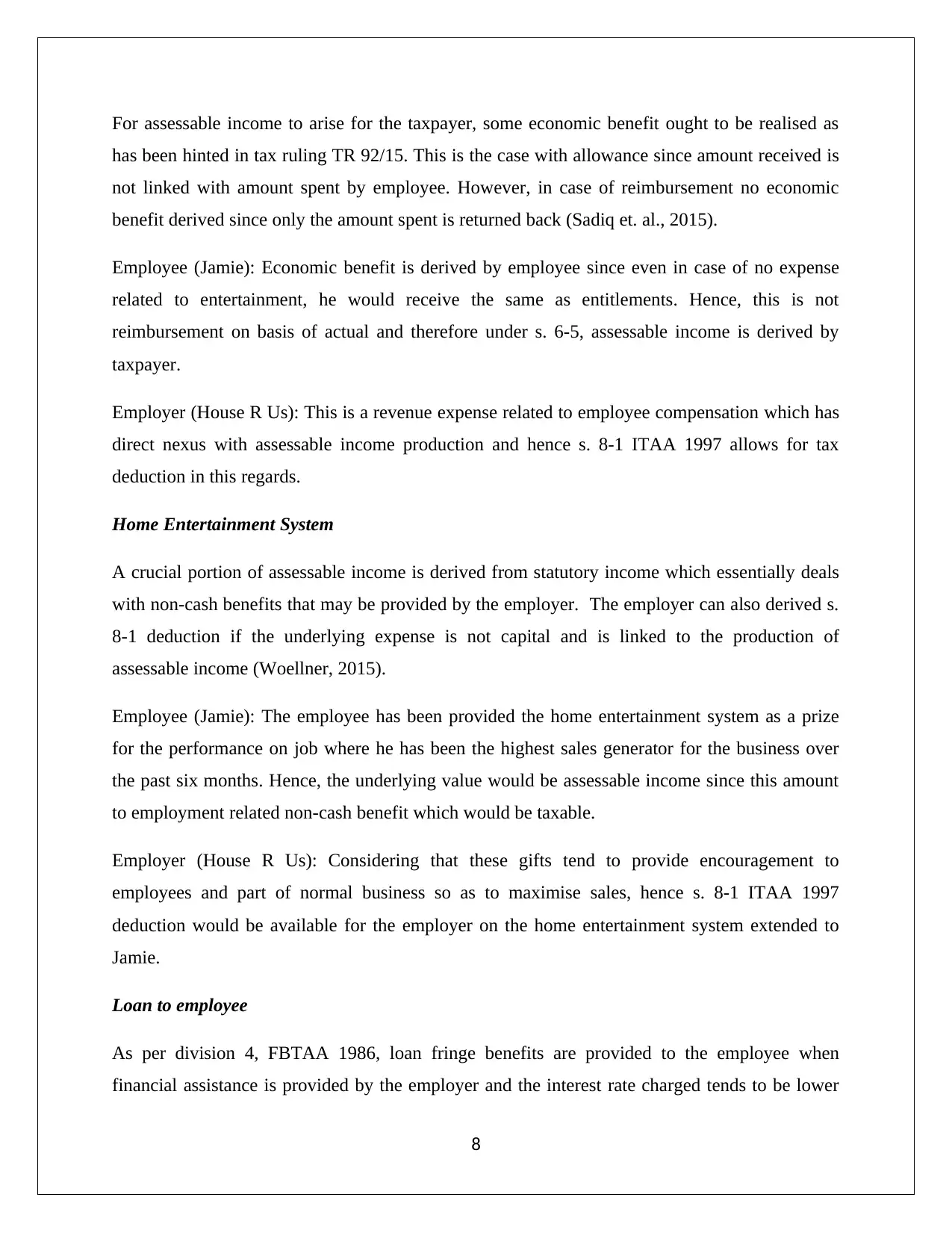
For assessable income to arise for the taxpayer, some economic benefit ought to be realised as
has been hinted in tax ruling TR 92/15. This is the case with allowance since amount received is
not linked with amount spent by employee. However, in case of reimbursement no economic
benefit derived since only the amount spent is returned back (Sadiq et. al., 2015).
Employee (Jamie): Economic benefit is derived by employee since even in case of no expense
related to entertainment, he would receive the same as entitlements. Hence, this is not
reimbursement on basis of actual and therefore under s. 6-5, assessable income is derived by
taxpayer.
Employer (House R Us): This is a revenue expense related to employee compensation which has
direct nexus with assessable income production and hence s. 8-1 ITAA 1997 allows for tax
deduction in this regards.
Home Entertainment System
A crucial portion of assessable income is derived from statutory income which essentially deals
with non-cash benefits that may be provided by the employer. The employer can also derived s.
8-1 deduction if the underlying expense is not capital and is linked to the production of
assessable income (Woellner, 2015).
Employee (Jamie): The employee has been provided the home entertainment system as a prize
for the performance on job where he has been the highest sales generator for the business over
the past six months. Hence, the underlying value would be assessable income since this amount
to employment related non-cash benefit which would be taxable.
Employer (House R Us): Considering that these gifts tend to provide encouragement to
employees and part of normal business so as to maximise sales, hence s. 8-1 ITAA 1997
deduction would be available for the employer on the home entertainment system extended to
Jamie.
Loan to employee
As per division 4, FBTAA 1986, loan fringe benefits are provided to the employee when
financial assistance is provided by the employer and the interest rate charged tends to be lower
8
has been hinted in tax ruling TR 92/15. This is the case with allowance since amount received is
not linked with amount spent by employee. However, in case of reimbursement no economic
benefit derived since only the amount spent is returned back (Sadiq et. al., 2015).
Employee (Jamie): Economic benefit is derived by employee since even in case of no expense
related to entertainment, he would receive the same as entitlements. Hence, this is not
reimbursement on basis of actual and therefore under s. 6-5, assessable income is derived by
taxpayer.
Employer (House R Us): This is a revenue expense related to employee compensation which has
direct nexus with assessable income production and hence s. 8-1 ITAA 1997 allows for tax
deduction in this regards.
Home Entertainment System
A crucial portion of assessable income is derived from statutory income which essentially deals
with non-cash benefits that may be provided by the employer. The employer can also derived s.
8-1 deduction if the underlying expense is not capital and is linked to the production of
assessable income (Woellner, 2015).
Employee (Jamie): The employee has been provided the home entertainment system as a prize
for the performance on job where he has been the highest sales generator for the business over
the past six months. Hence, the underlying value would be assessable income since this amount
to employment related non-cash benefit which would be taxable.
Employer (House R Us): Considering that these gifts tend to provide encouragement to
employees and part of normal business so as to maximise sales, hence s. 8-1 ITAA 1997
deduction would be available for the employer on the home entertainment system extended to
Jamie.
Loan to employee
As per division 4, FBTAA 1986, loan fringe benefits are provided to the employee when
financial assistance is provided by the employer and the interest rate charged tends to be lower
8
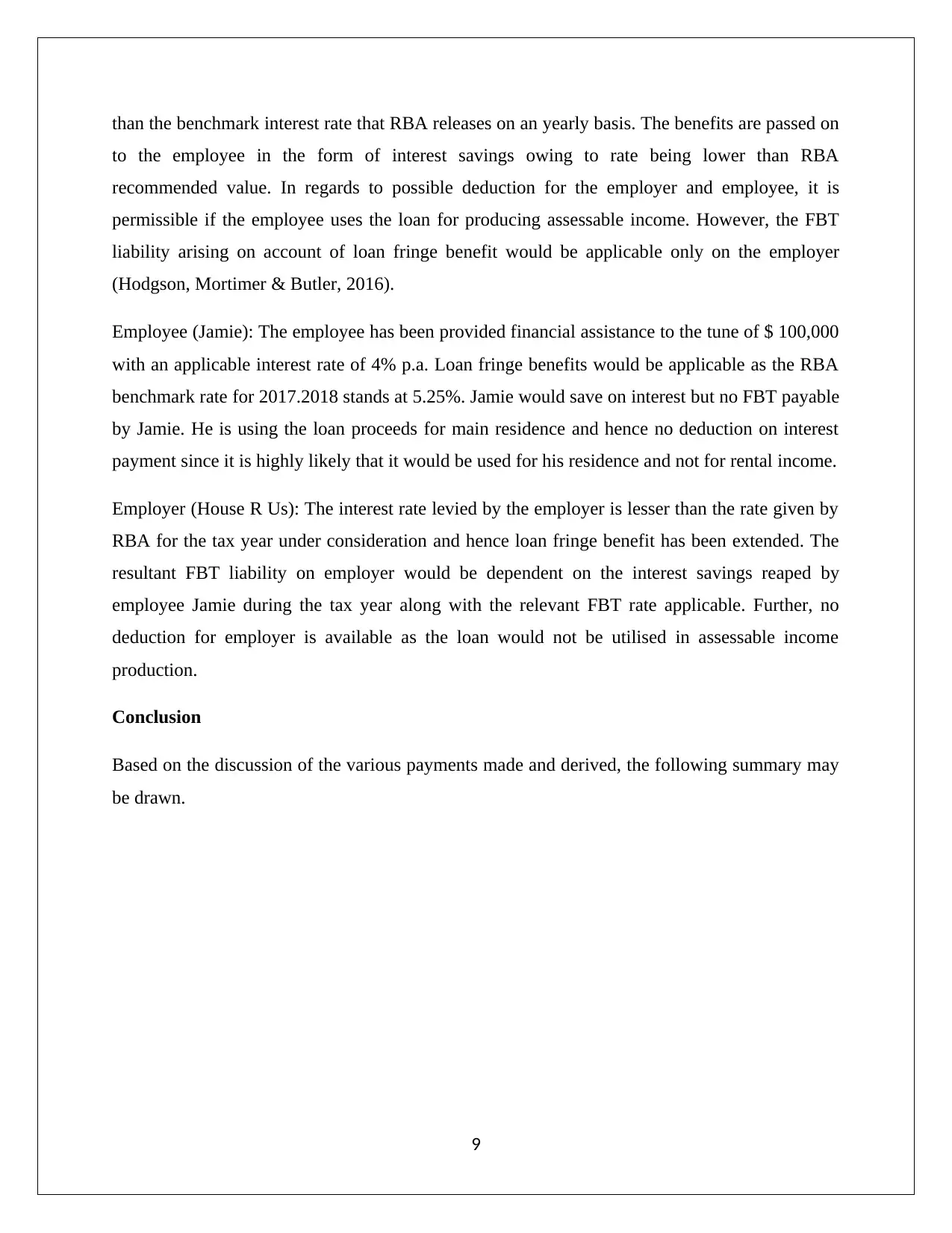
than the benchmark interest rate that RBA releases on an yearly basis. The benefits are passed on
to the employee in the form of interest savings owing to rate being lower than RBA
recommended value. In regards to possible deduction for the employer and employee, it is
permissible if the employee uses the loan for producing assessable income. However, the FBT
liability arising on account of loan fringe benefit would be applicable only on the employer
(Hodgson, Mortimer & Butler, 2016).
Employee (Jamie): The employee has been provided financial assistance to the tune of $ 100,000
with an applicable interest rate of 4% p.a. Loan fringe benefits would be applicable as the RBA
benchmark rate for 2017.2018 stands at 5.25%. Jamie would save on interest but no FBT payable
by Jamie. He is using the loan proceeds for main residence and hence no deduction on interest
payment since it is highly likely that it would be used for his residence and not for rental income.
Employer (House R Us): The interest rate levied by the employer is lesser than the rate given by
RBA for the tax year under consideration and hence loan fringe benefit has been extended. The
resultant FBT liability on employer would be dependent on the interest savings reaped by
employee Jamie during the tax year along with the relevant FBT rate applicable. Further, no
deduction for employer is available as the loan would not be utilised in assessable income
production.
Conclusion
Based on the discussion of the various payments made and derived, the following summary may
be drawn.
9
to the employee in the form of interest savings owing to rate being lower than RBA
recommended value. In regards to possible deduction for the employer and employee, it is
permissible if the employee uses the loan for producing assessable income. However, the FBT
liability arising on account of loan fringe benefit would be applicable only on the employer
(Hodgson, Mortimer & Butler, 2016).
Employee (Jamie): The employee has been provided financial assistance to the tune of $ 100,000
with an applicable interest rate of 4% p.a. Loan fringe benefits would be applicable as the RBA
benchmark rate for 2017.2018 stands at 5.25%. Jamie would save on interest but no FBT payable
by Jamie. He is using the loan proceeds for main residence and hence no deduction on interest
payment since it is highly likely that it would be used for his residence and not for rental income.
Employer (House R Us): The interest rate levied by the employer is lesser than the rate given by
RBA for the tax year under consideration and hence loan fringe benefit has been extended. The
resultant FBT liability on employer would be dependent on the interest savings reaped by
employee Jamie during the tax year along with the relevant FBT rate applicable. Further, no
deduction for employer is available as the loan would not be utilised in assessable income
production.
Conclusion
Based on the discussion of the various payments made and derived, the following summary may
be drawn.
9
Secure Best Marks with AI Grader
Need help grading? Try our AI Grader for instant feedback on your assignments.

10
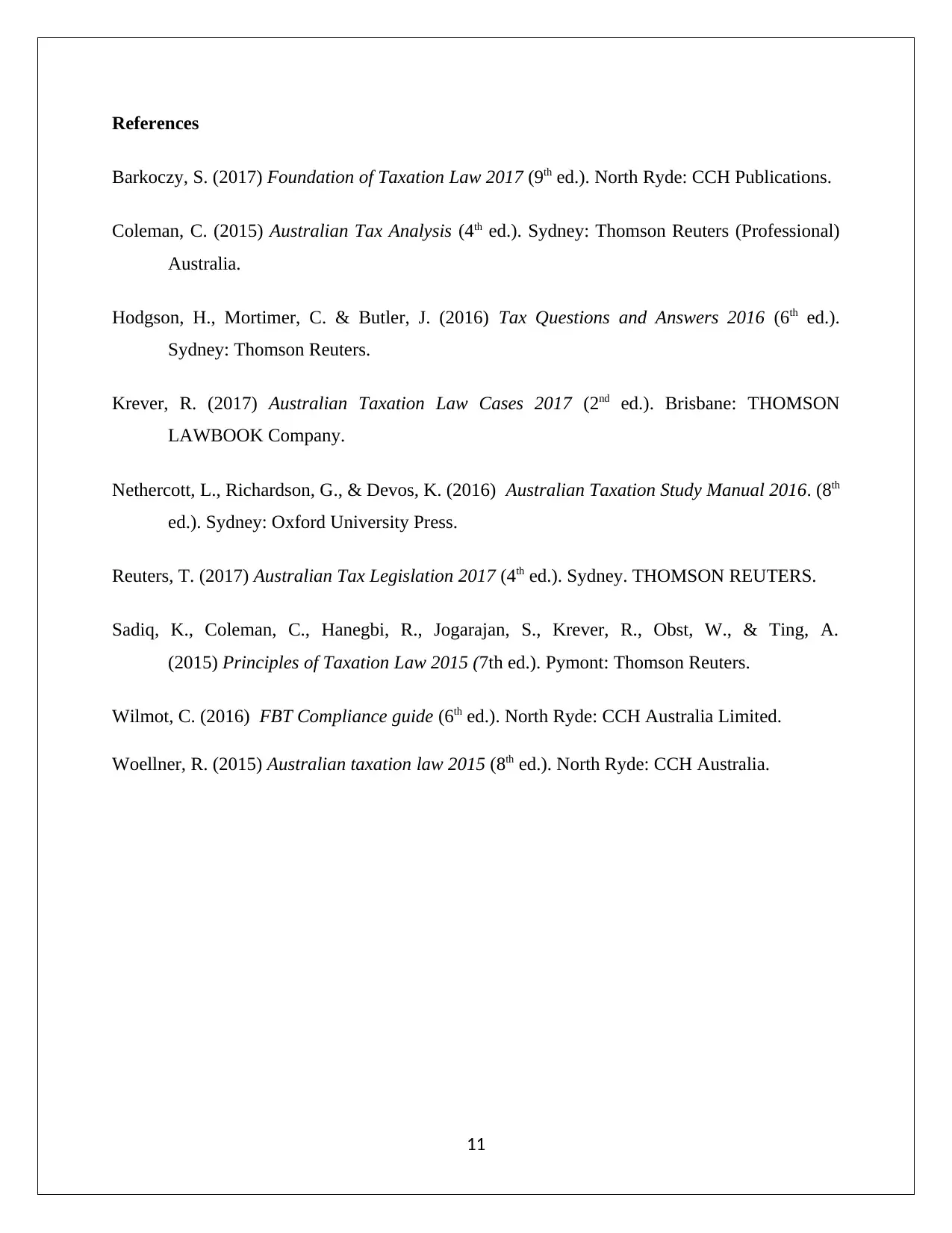
References
Barkoczy, S. (2017) Foundation of Taxation Law 2017 (9th ed.). North Ryde: CCH Publications.
Coleman, C. (2015) Australian Tax Analysis (4th ed.). Sydney: Thomson Reuters (Professional)
Australia.
Hodgson, H., Mortimer, C. & Butler, J. (2016) Tax Questions and Answers 2016 (6th ed.).
Sydney: Thomson Reuters.
Krever, R. (2017) Australian Taxation Law Cases 2017 (2nd ed.). Brisbane: THOMSON
LAWBOOK Company.
Nethercott, L., Richardson, G., & Devos, K. (2016) Australian Taxation Study Manual 2016. (8th
ed.). Sydney: Oxford University Press.
Reuters, T. (2017) Australian Tax Legislation 2017 (4th ed.). Sydney. THOMSON REUTERS.
Sadiq, K., Coleman, C., Hanegbi, R., Jogarajan, S., Krever, R., Obst, W., & Ting, A.
(2015) Principles of Taxation Law 2015 (7th ed.). Pymont: Thomson Reuters.
Wilmot, C. (2016) FBT Compliance guide (6th ed.). North Ryde: CCH Australia Limited.
Woellner, R. (2015) Australian taxation law 2015 (8th ed.). North Ryde: CCH Australia.
11
Barkoczy, S. (2017) Foundation of Taxation Law 2017 (9th ed.). North Ryde: CCH Publications.
Coleman, C. (2015) Australian Tax Analysis (4th ed.). Sydney: Thomson Reuters (Professional)
Australia.
Hodgson, H., Mortimer, C. & Butler, J. (2016) Tax Questions and Answers 2016 (6th ed.).
Sydney: Thomson Reuters.
Krever, R. (2017) Australian Taxation Law Cases 2017 (2nd ed.). Brisbane: THOMSON
LAWBOOK Company.
Nethercott, L., Richardson, G., & Devos, K. (2016) Australian Taxation Study Manual 2016. (8th
ed.). Sydney: Oxford University Press.
Reuters, T. (2017) Australian Tax Legislation 2017 (4th ed.). Sydney. THOMSON REUTERS.
Sadiq, K., Coleman, C., Hanegbi, R., Jogarajan, S., Krever, R., Obst, W., & Ting, A.
(2015) Principles of Taxation Law 2015 (7th ed.). Pymont: Thomson Reuters.
Wilmot, C. (2016) FBT Compliance guide (6th ed.). North Ryde: CCH Australia Limited.
Woellner, R. (2015) Australian taxation law 2015 (8th ed.). North Ryde: CCH Australia.
11
1 out of 12
Your All-in-One AI-Powered Toolkit for Academic Success.
+13062052269
info@desklib.com
Available 24*7 on WhatsApp / Email
![[object Object]](/_next/static/media/star-bottom.7253800d.svg)
Unlock your academic potential
© 2024 | Zucol Services PVT LTD | All rights reserved.




